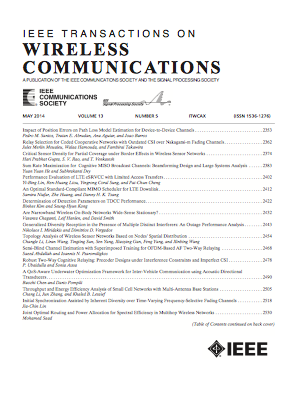Physical Layer Authentication for UAV Communications Under Rayleigh and Rician Channels
IF 10.7
1区 计算机科学
Q1 ENGINEERING, ELECTRICAL & ELECTRONIC
引用次数: 0
Abstract
In this paper, aimed to against spoofing attack, we propose a novel physical layer authentication (PLA) framework for unmanned aerial vehicle (UAV) communication networks under Rayleigh and Rician channels. A new PLA metric, called authentication distance (AD), is defined by jointly considering the geographical locations, elevation angles, and channel randomness between a legitimate sensor and a malicious spoofer. For Rayleigh channel in dense urban environment, the closed-form expressions for the false alarm probability (FAP) and miss detection probability (MDP) are obtained by adopting method of convolution and integration by parts. Next, the PLA hypothesis test model with Rician channel is established in suburban environment where both the Rician factor and the path loss exponent are functions of UAV altitude. To proceed, the expressions for the FAP and MDP are derived based on the doubly non-central F distribution. In addition, MDP minimization solutions subject to certain FAP requirement are developed in both Rayleigh and Rician channels by optimizing the detection threshold and UAV altitude jointly. Simulation results show that our derived analytical expressions of FAP and MDP match the Monte Carlo simulations well. Moreover, simulation results also imply the effectiveness of the proposed PLA framework for UAV communication networks.基于瑞利和瑞利信道的无人机通信物理层认证
针对欺骗攻击,提出了一种基于瑞利和瑞利信道的无人机通信网络物理层认证(PLA)框架。一种新的PLA度量,称为认证距离(AD),通过联合考虑合法传感器和恶意欺骗器之间的地理位置、仰角和信道随机性来定义。对于密集城市环境下的瑞利信道,采用卷积和分部积分的方法,得到了误报概率(FAP)和漏检概率(MDP)的封闭表达式。其次,在城郊环境下,建立了具有雷达通道的PLA假设检验模型,雷达因子和路径损失指数都是无人机高度的函数。接着,推导了基于双非中心F分布的FAP和MDP的表达式。此外,通过对探测阈值和无人机高度的共同优化,在Rayleigh和ricy信道上分别开发了符合一定FAP要求的MDP最小化方案。仿真结果表明,我们推导的FAP和MDP解析表达式与蒙特卡罗模拟结果吻合较好。此外,仿真结果也暗示了所提出的PLA框架用于无人机通信网络的有效性。
本文章由计算机程序翻译,如有差异,请以英文原文为准。
求助全文
约1分钟内获得全文
求助全文
来源期刊
CiteScore
18.60
自引率
10.60%
发文量
708
审稿时长
5.6 months
期刊介绍:
The IEEE Transactions on Wireless Communications is a prestigious publication that showcases cutting-edge advancements in wireless communications. It welcomes both theoretical and practical contributions in various areas. The scope of the Transactions encompasses a wide range of topics, including modulation and coding, detection and estimation, propagation and channel characterization, and diversity techniques. The journal also emphasizes the physical and link layer communication aspects of network architectures and protocols.
The journal is open to papers on specific topics or non-traditional topics related to specific application areas. This includes simulation tools and methodologies, orthogonal frequency division multiplexing, MIMO systems, and wireless over optical technologies.
Overall, the IEEE Transactions on Wireless Communications serves as a platform for high-quality manuscripts that push the boundaries of wireless communications and contribute to advancements in the field.

 求助内容:
求助内容: 应助结果提醒方式:
应助结果提醒方式:


